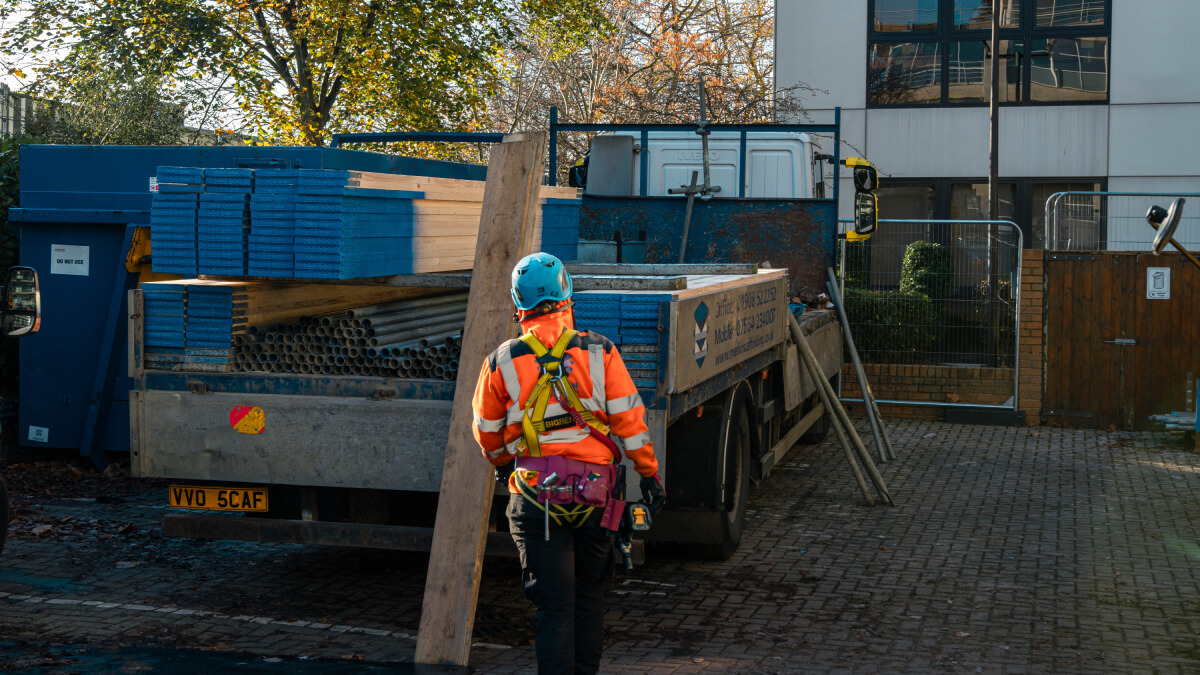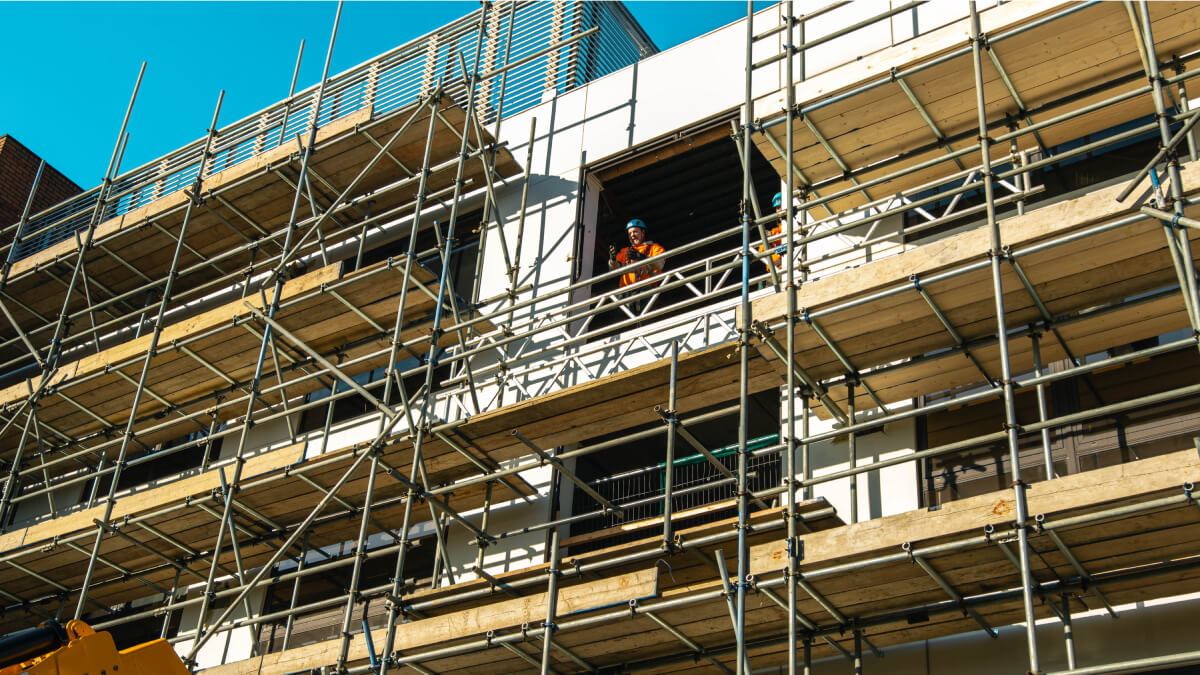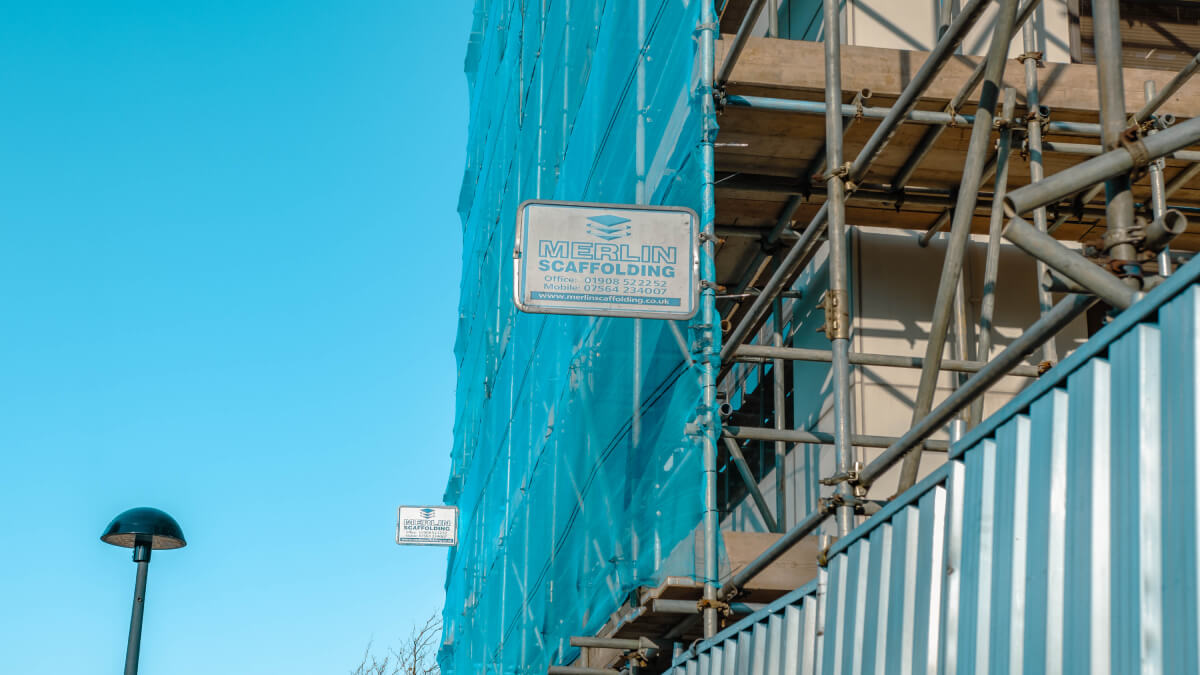Safety is everything in scaffolding. Whether you’re planning a simple home renovation or overseeing a major construction project, understanding how to control scaffold-related hazards can literally save lives. At Merlin Scaffolding, we’ve been delivering the highest standard of scaffolding in Milton Keynes for over 20 years, so we’re expertly placed to answer the question, ‘How can hazards associated with scaffolds be controlled?’.
Merlin Scaffolding Guide: How Can Hazards Associated With Scaffolds Be Controlled?
In this comprehensive guide, we’ll walk you through the most common scaffolding hazards and provide clear, practical advice on how to control them effectively. This article will benefit two main groups of people:
- Property owners and project managers who are planning to use scaffolding and want to ensure the utmost safety
- Individuals training to become scaffolders who need to understand essential safety protocols
By the end of this article, you’ll have a solid understanding of scaffold safety measures and feel confident in implementing them on your next project.
- Is Scaffolding Dangerous?
- Erecting Scaffolding
- Overloaded Scaffolding
- Scaffolding Weather Protection
- Electrical Hazards
- Employee Training

Is Scaffolding Dangerous?
The short answer is: scaffolding can be dangerous if proper safety measures aren’t followed. Working at height always carries risks, and scaffolding adds another layer of complexity.
According to the Health and Safety Executive (HSE), falls from height remain one of the biggest causes of workplace fatalities and major injuries in the UK construction industry. In fact, recent statistics show that falls from height account for nearly 30% of all fatal injuries to workers, with many of these incidents involving scaffolding.
Here are some statistics to put things into perspective:
- 50 people died last year in the UK due to falls from height
- Over 4,000 workers suffer serious injuries from falls annually
- Approximately 15% of all reported construction accidents involve scaffolding
These numbers highlight why strict safety protocols aren’t just recommendations — they’re essential life-saving measures. When you’re working several metres above ground level, even small mistakes can have huge consequences.
This is precisely why it’s crucial to recruit a highly trained and properly insured scaffolding team, like Merlin Scaffolding, for your project. Professional scaffolders undergo rigorous training and follow strict safety guidelines to minimise risks. They understand the complexity of scaffold structures and know how to erect, maintain, and dismantle them safely.

Erecting Scaffolding
The assembly phase is when many scaffolding accidents occur. Here are the key hazards associated with erecting scaffolding and how to control them:
Hazard: Unstable Ground
Scaffolding erected on uneven or soft ground can shift, tilt, or collapse entirely.
Control Measures:
- Conduct thorough ground assessments before beginning assembly
- Use base plates and sole boards to distribute weight evenly
- Ensure adequate drainage to prevent ground softening
Hazard: Structural Weakness
Poor design or substandard components can lead to catastrophic failure.
Control Measures:
- Always use scaffolding components that meet British Standards (BS EN 12810-1)
- Follow manufacturer guidelines regarding load capacity and set up
- Use a tagging system to identify and remove damaged components
- Have qualified engineers review complex or unusual scaffold designs
Hazard: Falls During Assembly
Workers are at particular risk when erecting the scaffold before all guardrails are in place.
Control Measures:
- Use proper personal fall arrest systems during assembly
- Employ the ‘advanced guardrail’ system where temporary guardrails are installed from the level below
- Establish clear assembly procedures with safety checkpoints
- Never allow workers to climb on scaffold components not designed for climbing
Overloaded Scaffolding
One of the most common causes of scaffold collapse is exceeding the maximum load capacity. Here’s how to address this serious hazard:
Hazard: Excessive Weight
Scaffolding that holds more weight than it was designed for is at risk of collapsing.
Control Measures:
- Clearly mark load limits on scaffold structures
- Train workers to understand and respect load limits
- Distribute weight evenly across the scaffold platform
- Consider the combined weight of workers, tools, and materials
- Conduct regular inspections to ensure limits aren’t exceeded
Hazard: Dynamic Loads
Activities like jumping, dropping heavy objects, or using powerful tools can create sudden forces that exceed the scaffold’s weight limit.
Control Measures:
- Train workers to avoid creating sudden impacts on scaffold platforms
- Provide separate structures for activities that create vibration or impact
- Use shock-absorbing mats when necessary
- Implement strict policies against horseplay on scaffolding
Hazard: Material Storage Issues
Failure to store materials properly can create dangerous imbalances and trip hazards.
Control Measures:
- Create dedicated material storage areas away from scaffold edges
- Never allow materials to accumulate on scaffolding platforms
- Establish clear protocols for material delivery and removal
- Consider using material hoists for heavier items
Scaffolding Weather Protection
Adverse weather conditions are among the main hazards associated with scaffolding. Here’s how to control these environmental hazards:
Hazard: High Winds
Strong winds can destabilise scaffolding and create dangerous working conditions.
Control Measures:
- Follow wind speed guidelines (typically work should stop when wind speeds exceed 23mph)
- Use weather monitoring systems on site
- Secure or remove loose materials before high winds arrive
- Consider wind loads during the design phase and use ties accordingly
- Install wind shields on exposed scaffolding where appropriate
Hazard: Rain and Wet Conditions
Wet conditions increase slip hazards and can affect ground stability.
Control Measures:
- Use slip-resistant platform materials
- Ensure proper drainage systems are built into scaffold designs
- Cover materials that shouldn’t get wet
- Provide workers with appropriate footwear
- Implement regular inspections after heavy rainfall
Hazard: Extreme Temperatures
Both hot and cold weather can create additional risks.
Control Measures:
- In hot weather, provide shade and schedule frequent breaks
- In cold conditions, clear ice and snow promptly
- Adjust work schedules to avoid the most extreme weather periods
- Consider how temperature affects material properties (expansion/contraction)
Hazard: Lightning
Metal scaffolding can attract lightning strikes.
Control Measures:
- Cease work and evacuate scaffolding during thunderstorms
- Use lightning detection systems on larger sites
- Establish clear emergency procedures for severe weather events
- Consider proper grounding for very tall scaffold structures

Electrical Hazards
When scaffolding interacts with electrical systems, the risks can be particularly severe. Here’s how to manage these hazards:
Hazard: Overhead Power Lines
When metal scaffolding comes in contact with power lines, workers are at risk of electrocution.
Control Measures:
- Conduct thorough site surveys to identify all overhead lines
- Maintain safe distances (typically at least 3 metres from power lines)
- Use non-conductive materials for screens and barriers where proximity is unavoidable
- Consult with utility companies about de-energising lines during work if necessary
- Consider scaffold design to maintain clearance from power sources
Hazard: Electrical Equipment on Scaffolding
Power tools and lighting systems create additional electrical risks on scaffolding.
Control Measures:
- Use low-voltage systems where possible
- Implement proper cable management to prevent trips and damage
- Require RCD (residual current device) protection for all electrical equipment
- Schedule regular testing of all electrical equipment
- Train workers on electrical safety specific to scaffolding environments
Hazard: Wet Conditions Combined with Electricity
Water dramatically increases electrical hazards.
Control Measures:
- Use only weatherproof electrical fittings rated for outdoor use
- Inspect all connections before use, especially after rain
- Implement strict procedures for powering down systems during wet weather
- Provide proper storage for electrical equipment when not in use

Employee Training
Perhaps the most important control measure for scaffold safety is comprehensive employee training. Well-trained workers can identify and respond to hazards before they lead to accidents.
Essential Training Elements
All scaffolding workers should receive training in:
- Scaffold classification and types
- Load calculations and weight distribution
- Assembly and dismantling procedures
- Fall protection systems
- Hazard identification
- Emergency protocols
- Equipment inspection
- Weather safety
- Proper use of personal protective equipment (PPE)
Ongoing Education
Scaffold safety isn’t a one-time lesson. The most effective training programmes include:
- Regular refresher courses
- Updates on new safety regulations and equipment
- Toolbox talks specific to current projects
- Incident reviews to learn from near-misses
- Practical exercises and simulations
Certification
In the UK, scaffolders should work towards recognised qualifications such as:
- CISRS (Construction Industry Scaffolders Record Scheme) cards
- NASC (National Access and Scaffolding Confederation) training
- Site-specific competency assessments
These certifications not only improve safety but also demonstrate professionalism and commitment to quality. At Merlin Scaffolding, we’re proud NASC members. So, when you choose to work with us, you can have peace of mind knowing your working with a team of highly trained and accredited scaffolders.

Practice Safe Scaffolding
Throughout this article, we’ve explored the many hazards associated with scaffolding and the practical measures you can take to control them. Safety isn’t just about following rules – it’s about creating a culture where everyone takes responsibility for preventing accidents.
When planning your next construction or renovation project, remember that choosing the right scaffolding partner is perhaps the most important safety decision you’ll make. An experienced scaffolder in Milton Keynes, like those on our team at Merlin Scaffolding, brings not just equipment but expertise and a proven safety record to your project.
If you’d like to learn more about our safety-first approach to scaffolding or discuss your upcoming project, we’re always happy to help. With our extensive experience and commitment to safety, we’ll ensure your scaffolding needs are met with the highest standards of professionalism and care. Get in touch to discuss your project.
